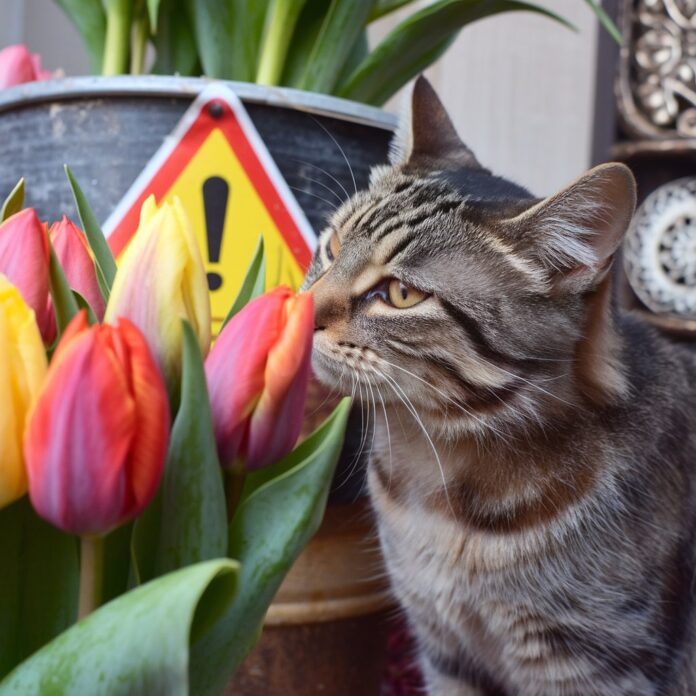Are tulips toxic to cats? Yes, tulips can be harmful to your feline friends. These beautiful spring flowers contain toxic compounds, such as glycosides, which can cause serious health issues if ingested by cats. In this guide, we will explore the dangers tulips pose to cats, the symptoms of poisoning, and how to keep your cat safe from these toxic plants.
Key Takeaways
- Tulips contain toxic compounds that can harm cats if they eat them.
- The bulbs, leaves, and flowers of tulips are all toxic to cats.
- Some tulip types are riskier than others. Knowing the types in your garden is key.
- Symptoms of tulip poisoning in cats can include stomach problems to serious issues. Quick vet care is needed.
- Keeping tulips away from your cat and offering safe plants can protect them.
Understanding Tulip Toxicity in Cats
Keeping our cats safe means knowing about dangers in our homes. Tulips, a favorite spring flower, can be harmful. It’s key for pet owners to know about tulip chemicals and their effects on cats.
Chemical Compounds in Tulips
Tulips have toxic compounds called glycosides. These, like tuliposide A and tulipalin A, can harm cats. They can cause serious problems in our pets.
Most Dangerous Parts of the Tulip Plant
- The bulb of the tulip plant is the most toxic, with the highest levels of harmful chemicals.
- The leaves, stems, and flowers also have toxic compounds, but less than the bulb.
Toxicity Levels in Different Tulip Varieties
Not all tulips are equally toxic. Single-colored tulips are generally less toxic than multi-colored or variegated tulips. The tulip’s age and growing conditions also affect its toxicity.
| Tulip Variety | Toxicity Level |
|---|---|
| Single-colored tulips | Lower toxicity |
| Multi-colored or variegated tulips | Higher toxicity |
Knowing about different tulip varieties helps pet owners keep their cats safe. This knowledge helps avoid harm from tulips.

Are Tulips Toxic to Cats: What Every Pet Owner Should Know
As devoted cat owners, we often put our pets first. But we shouldn’t forget about our own well-being. Knowing if are tulips safe for cats is key for every pet parent.
Tulips are a favorite in the spring, but they can be dangerous for cats. The bulbs, leaves, and flowers have toxic compounds. These can harm or even kill cats if they eat them.
Understanding which tulips are toxic and which parts are most dangerous helps. This knowledge keeps our cats safe and reduces our stress. A pet emergency can affect both the animal and the owner.
“The health and safety of our pets should always be our top priority. Educating ourselves about the potential risks of household plants is a crucial step in creating a harmonious, cat-friendly home.”
We’ll explore tulip toxicity, signs of exposure, and prevention steps next. With this knowledge, we can keep our well-being and our cats’ safe and balanced.

Common Signs and Symptoms of Tulip Poisoning in Cats
If your cat has eaten tulips, it’s important to know the signs of tulip poisoning. These colorful flowers can be harmful to your cat. Their chemicals can hurt your cat’s health.
Immediate Symptoms to Watch For
When a cat eats tulips, it can get sick fast. Look for signs like vomiting, drooling, and lethargy. In serious cases, your cat might have abdominal pain, diarrhea, and trouble breathing. You need to see a vet right away.
Long-term Effects of Tulip Exposure
The first signs of tulip poisoning are scary, but the long-term effects are worse. Tulips can harm your cat’s kidneys, liver, and heart. These problems might not show up right away. So, watch your cat’s health closely.
When to Contact Your Veterinarian
If you think your cat ate a tulip, call your vet fast. Quick action is key to treating tulip poisoning. Your vet might give your cat medicine to make them vomit or help their body recover.
Being quick and careful can save your cat from tulip poisoning. Knowing the signs helps keep your cat safe. This way, you can protect your cat from harm.
Emergency Steps If Your Cat Eats Tulips
If you think your cat has eaten tulips, act fast. Tulips can be dangerous for cats. Quick action is key to prevent serious harm. Here’s what to do if your cat eats tulips:
- Remove your cat from the area: Quickly remove your cat from the vicinity of the tulips to prevent further exposure and ingestion.
- Assess the situation: Observe your cat closely for any signs of distress, such as drooling, vomiting, or lethargy. These can be early indicators of tulip toxicity.
- Contact your veterinarian: Immediately call your veterinarian or the nearest emergency animal hospital. They can provide guidance on the appropriate next steps and whether your cat requires immediate medical attention.
- Avoid inducing vomiting: Unless specifically instructed by a veterinary professional, do not try to induce vomiting. This could potentially worsen the situation.
- Gather information: Provide your veterinarian with details about the type and amount of tulips your cat may have consumed, as well as the time of exposure.
When it comes to tulip poisoning in cats, time is crucial. Quick vet help can greatly improve your cat’s chances of recovery. Always put your cat’s safety first.
Being ready and knowing the risks helps protect your cat from tulip harm. Stay alert and seek vet help if you think your cat has eaten these flowers.
Prevention Strategies: Keeping Cats Away from Tulips
As pet owners, we must protect our cats from tulips and other harmful plants. By using smart prevention methods, we can keep our pets safe. This way, we can make a happy, cat-friendly space for everyone.
Safe Garden Design Tips
Here are some tips for a pet-friendly garden:
- Choose cat-safe plants like cut flowers that are not poisonous to cats.
- Use fences or raised beds to keep cats away from tulips.
- Use materials like gravel or plant mulch that cats don’t like.
Indoor Plant Alternatives
If you have little outdoor space or prefer indoor living, try these cat-friendly indoor plants:
- Catnip (Nepeta cataria)
- Cat grass (Triticum aestivum)
- Spider plants (Chlorophytum comosum)
- Pilea peperomioides
Creating Cat-Free Zones
Make areas with tulips or other harmful plants “cat-free” zones. You can do this by:
- Putting up baby gates or door screens in certain rooms.
- Using ultrasonic or motion-activated devices to scare cats away.
- Providing toys and scratching posts in other areas to keep cats busy.
With these strategies, you can keep your cats safe and enjoy tulips in your home or garden.
Safe Flowers and Plants for Cat-Friendly Homes
We all want to make our homes safe and comfy for our cats. Tulips are pretty but can be dangerous for our feline friends. Luckily, there are many cat-safe flowers and plants that are safe and beautiful.
Choosing flowers that are not poisonous to cats is key. Safe picks include African violets, Gerber daisies, and Zinnias. These flowers are not only lovely but also safe for cat owners.
There are also cut flowers that are not poisonous to cats like roses, carnations, and chrysanthemums. These flowers make great arrangements that won’t harm your curious cat.
- African Violets
- Gerber Daisies
- Zinnias
- Roses
- Carnations
- Chrysanthemums
Adding these cat-friendly plants to your home and garden is a great idea. It makes your space beautiful and safe for your cat. Being a responsible pet owner means finding a balance between beauty and safety. With a bit of research, you can have both.
“The true joy of gardening lies in creating a space that nurtures both our senses and our pets’ safety.”
Treatment Options for Tulip Poisoning in Cats
If your cat has eaten tulips, it’s important to act fast. Tulips can be very harmful to cats. Getting your cat to a vet quickly is key to their health. Let’s look at the treatments for tulip poisoning in cats.
Veterinary Interventions
Take your cat to the vet if they’ve eaten tulips. The vet will check how bad the poisoning is. They will then decide what to do next. This might include:
- Inducing vomiting to remove any remaining plant material from the cat’s digestive system
- Administering activated charcoal to absorb toxins
- Providing intravenous fluids to prevent dehydration and support the cat’s organ function
- Prescribing medication to alleviate symptoms and manage pain
Home Care After Treatment
After your cat sees the vet, keep an eye on them at home. This means:
- Limiting your cat’s activity and providing a quiet, comfortable environment for rest
- Administering any prescribed medications as directed by your veterinarian
- Offering small, frequent meals of a bland, easily digestible diet to prevent further gastrointestinal upset
- Closely observing your cat for any signs of continued toxicity, such as vomiting, diarrhea, or lethargy, and contacting your veterinarian if these symptoms persist
By following your vet’s advice, you can help your cat get better. This will also prevent any long-term health issues.
Understanding Cat Behavior Around Toxic Plants
As pet owners, we often put our cats’ needs first. Their curiosity can lead them to explore plants that might be are tulips toxic to cats. Knowing why they do this helps us keep them safe.
Cats are naturally curious and love to explore. This includes plants, even those that could be our well-being often takes a backseat to our furry companions. Tulips, for example, have compounds like tulipalin A and B that can harm cats if they eat them.
- Cats might be drawn to tulips’ texture, color, or smell. They might chew on the leaves, stems, or flowers.
- They might not know to avoid harmful plants because of their curiosity.
- Not having enough to do can make cats more interested in plants.
Knowing why cats are attracted to toxic plants helps us keep them safe. We can make our homes safer for them. This way, we can keep our cats happy and healthy while enjoying our own space.
“Keeping our cats safe from harm is a top priority, and understanding their behavior around potentially toxic plants is a crucial step in achieving that goal.”
Seasonal Considerations: When Tulips Pose the Greatest Risk
As pet owners, it’s key to know that are tulips dangerous for cats and other how flowers are poisonous to cats risks change with the seasons. Tulips are especially risky for cats during certain times of the year.
In the spring, tulips are blooming and cats find them tempting. As gardens wake up, it’s crucial to keep cats away from these flowers.
But tulips are a risk all year, especially when bulbs are dug up. Cats might play with or eat these bulbs, causing serious health issues.
To keep your cat safe, know when tulips grow and take steps to prevent access. This way, you can reduce the risk of your cat getting sick from tulips.
“The best way to protect your cat is to be vigilant about their environment and the plants they have access to, especially during peak tulip season.”
With a bit of extra care, you can ensure your cat stays safe and healthy. This is true even when facing the dangers of are tulips dangerous for cats and how flowers are poisonous to cats.
Creating a Pet-Safe Garden Environment
Creating a beautiful garden that’s safe for cats is a fun challenge. We love gardening and taking care of pets. We know how important it is to have a garden that’s safe for your cat.
By using pet-friendly plants and keeping harmful ones away, you can make a garden that’s safe for your cat. This way, your garden will be beautiful and safe for your curious kitty.
Alternative Garden Plants
Many flowers are toxic to cats, like tulips. But, there are many beautiful, cat-safe plants you can use in your garden. Some of our favorites include:
- Catnip (Nepeta cataria)
- Lavender (Lavandula spp.)
- Marigolds (Tagetes spp.)
- Sunflowers (Helianthus spp.)
- Zinnias (Zinnia elegans)
These plants are not only pretty and fragrant, but they’re also safe for your cat. They let your cat explore and enjoy the outdoors safely.
Protective Barriers and Deterrents
To keep your garden safe from curious cats, use barriers and natural deterrents. Fencing, dense bushes, or raised beds can keep cats out of trouble. You can also use citrus peels or strong-smelling herbs to keep cats away from plants.
Designing your garden with your cat in mind makes it a safe and beautiful place for both of you. With a little creativity, your garden can become a wonderful place for you and your pet.
Conclusion
We’ve learned how important it is to keep our pets safe from tulips. Our pets’ health should be our top priority. Knowing which tulips are toxic and how to prevent poisoning helps keep our pets safe.
Ensuring our cats’ safety is a big responsibility. By being careful and informed, we can make sure our pets have a happy and safe home. This way, they can enjoy their lives without worrying about tulips.
Being a good pet owner means more than just feeding and caring for them. It’s about creating a safe space for them to grow and thrive. By understanding and avoiding the dangers of tulips, we protect our pets and make our homes better for everyone.
FAQ
Are tulips poisonous to cats?
Yes, tulips can be very harmful to cats. The bulbs, leaves, and flowers have chemicals called glycosides. These can cause serious problems in cats’ stomachs and brains if they eat them.
What parts of the tulip plant are most dangerous for cats?
The tulip bulbs are the most toxic for cats. But, the leaves, stems, and flowers can also be dangerous if cats eat them.
How poisonous are tulips to cats?
Tulips are very poisonous to cats. The danger level can change based on the type of tulip. But, even a little bit can cause big health problems.
What should I do if my cat eats tulips?
If your cat eats tulips, call your vet right away. Quick help is key to stop or fix the bad effects of tulip poisoning.
Are there any tulip varieties that are safer for cats?
No, all tulips are toxic to cats. There’s no safe tulip for cats. It’s best to not have tulips where cats live.
What are the symptoms of tulip poisoning in cats?
Cats with tulip poisoning might vomit, have diarrhea, feel tired, not want to eat, and drool a lot. They could also have an odd heartbeat, trouble breathing, and seizures.
How can I prevent my cat from accessing tulips?
To keep your cat safe, don’t have tulips or other toxic plants at home or in your garden. Use barriers, make areas cat-free, and pick safe plants for your home.
What are some safe flower options for a cat-friendly home?
There are many safe flowers for homes with cats, like carnations, roses, sunflowers, and zinnias. Always check if a plant is safe for cats before bringing it home.
For more health tips and wellness advice, explore Negony.com and discover valuable insights to help you live a healthier, happier life.


























